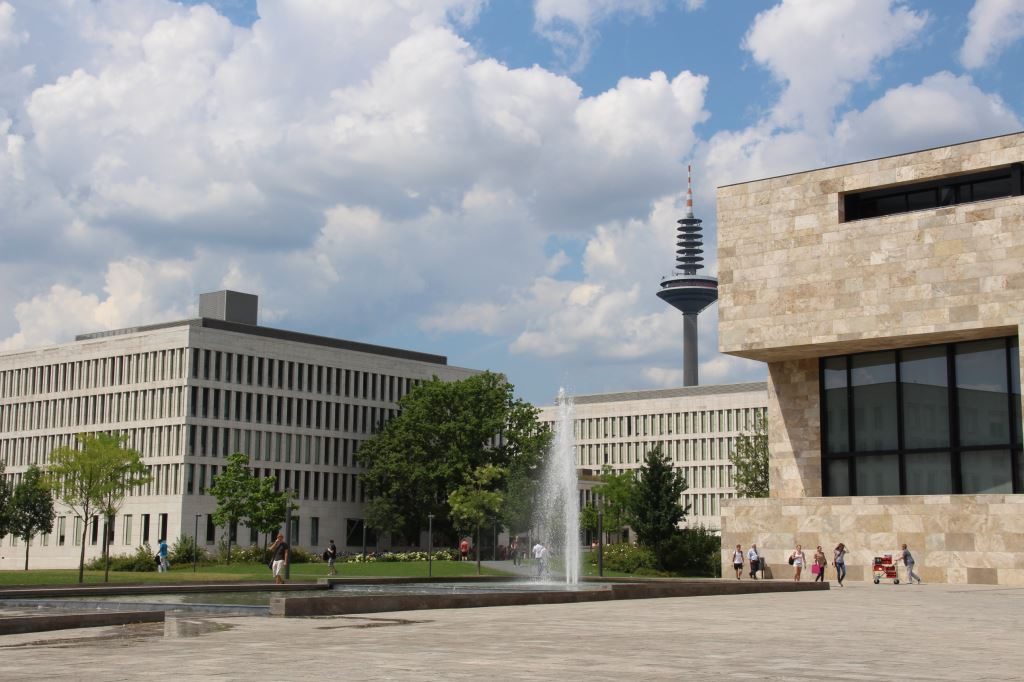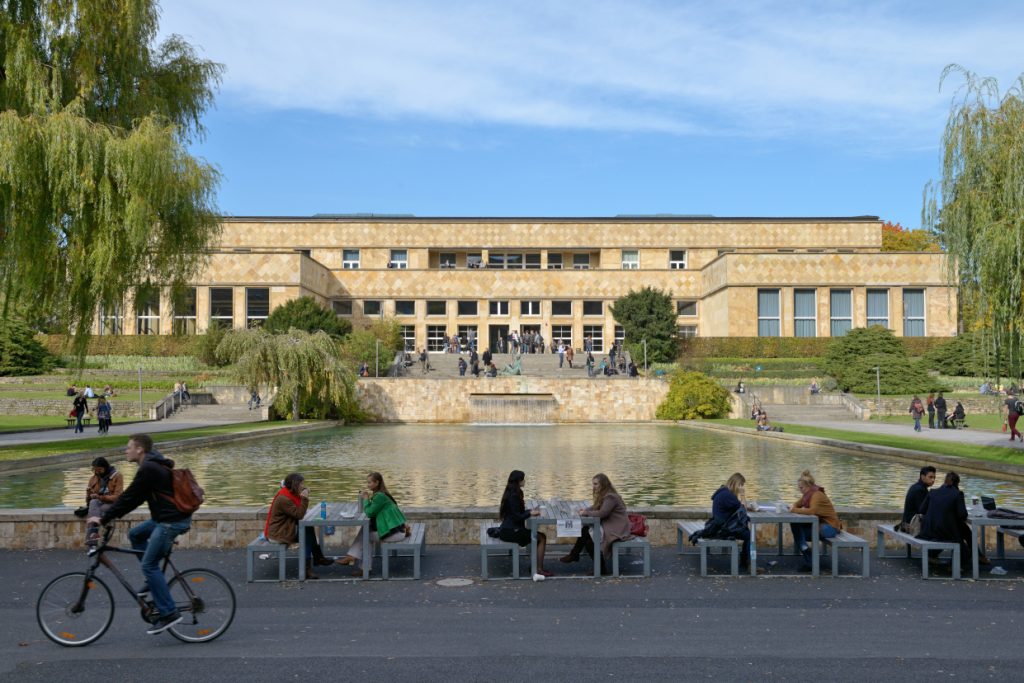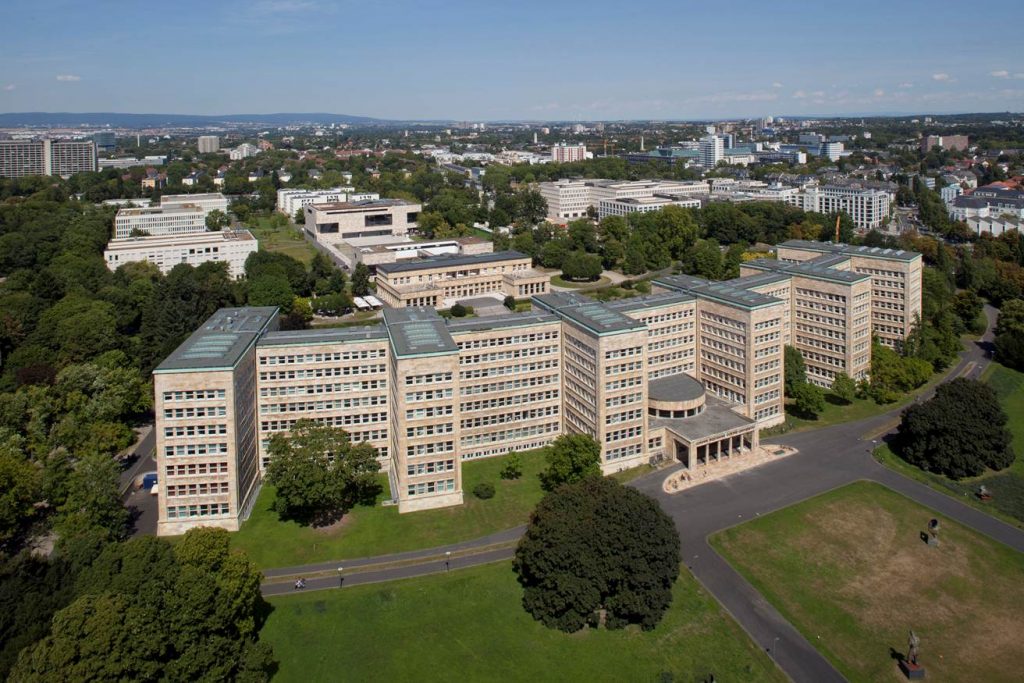Location
Goethe University – Campus Westend

LAK20 will take place at the Campus Westend. “Germany’s most beautiful campus.” Is located to the north-west of the city. Goethe University Campus Westend offers state-of-the-art conditions for study.
Frankfurt’s Goethe University Campus Westend disposes a wide range of facilities ideally suited for the LAK conference, i.e., conference and seminar rooms, an auditorium, several ballrooms, the Eisenhower Rotunda, a historical auditorium and lecture halls featuring the most modern technical equipment.

© #visitfrankfurt; Holger Ullmann
To host the conference sessions the campus features a new lecture hall center with an 800 m² foyer on the ground floor, flexible conference rooms suited for 130, 260, or even 600 participants, and modern seminar rooms for up to 100 participants.
The conference reception and poster sessions can take place at the Eisenhower Rotunda with impressive architectural design and a magnificent view to the countryside.
IG Farben Building

The historic IG Farben Building, also known as Poelzig Building, is the most iconic building at the Campus Westend. It was constructed from 1928 to 1930 as the corporate headquarters of the IG Farben conglomerate, then the world‘s largest chemical company and the world‘s fourth-largest company overall. The building was the HQ for production administration of chemical and pharmaceutical products, and for research projects relating to the development of synthetic oil and rubber. Notably IG Farben scientists discovered the first antibiotic, fundamentally reformed medical research and “opened a new era in medicine.”
The company and the Poelzig building also has a very dark chapter in its history. The company became a donor to the National Socialist party in the 1930s, and was a large government contractor after 1933, providing material for the German war effort and becoming embroiled in regime policy, including the use of slave labor at IG Farben’s Buna facility at Auschwitz, and the use of its minority-owned subsidiary’s Zyklon B poison gas in the Holocaust.
After World War II, the IG Farben Building served as the headquarters for the Supreme Allied Command and from 1949 to 1952 the High Commissioner for Germany. Notably Dwight D. Eisenhower had his office in the building. It became the principal location for implementing the Marshall Plan, which supported the post-war reconstruction of Europe. In 1948, the Frankfurt Documents, which led to the creation of a West German state allied with the western powers, were signed here. The IG Farben Building served as the headquarters for the US Army’s V Corps and the Northern Area Command until 1995. It was also the HQ of the CIA in Germany, informally referred to as “The Pentagon of Europe”.
In 1995, the US Army transferred the IG Farben Building to the German government, and it was purchased by the state of Hesse on behalf of the University of Frankfurt. The building underwent a restoration and was opened as part of the university in 2001. It is the central building of the West End Campus of the university. The University and the state of Hesse extended the complex with modern buildings in the same design and placed all social science disciplines around the original IG Farben building to underline its humanistic research focus for a future democratic society.
About Frankfurt

The City of Frankfurt am Main is the metropolis of the German state of Hesse and the fifth-largest city in Germany. Frankfurt is a global hub for commerce, culture, education, tourism, transportation and data. It is the home of the largest European airport with over 60 Million passengers per year, which is just 11 minutes on the train from the city center. Frankfurt also hosts the biggest national and international internet data node that processes 90 % of all domestic and 35 % of all European Internet traffic. Effective and efficient infrastructures of all kinds are at the heart of Frankfurt and made it ‘the site to be’ for countless companies, component suppliers and service providers.
Frankfurt is not only an infrastructure hub but also characterised by green parks, e.g. the central Wallanlagen, the City Forest and two major botanical gardens, the Palmengarten and the University’s Botanical Garden. Frankfurt is located on both sides of the river Main, south-east to the Taunus mountain range. The Frankfurt City Forest, to the south, is Germany’s largest city forest.
Frankfurt is also rich and colorful in history and culture: The medieval old town has recently been extensively reconstructed. St. Paul’s Church was the seat of the 1848 Frankfurt Parliament, the first freely elected German legislative body. More than 15 museums can be found on both banks of the Main or in its vicinity, situated in historic villas or in architecturally interesting modern buildings.
Frankfurt also offers a delicious local kitchen accompanies by the light-alcoholic Apple Wine, until the famous Riesling Wines from the river Rhein, as many small beer breweries. Frankfurt is also known for its famous sausages ‘Frankfurters’ and being the birthplace of techno and electronic music with the famous OMEN club from Sven Väth.
